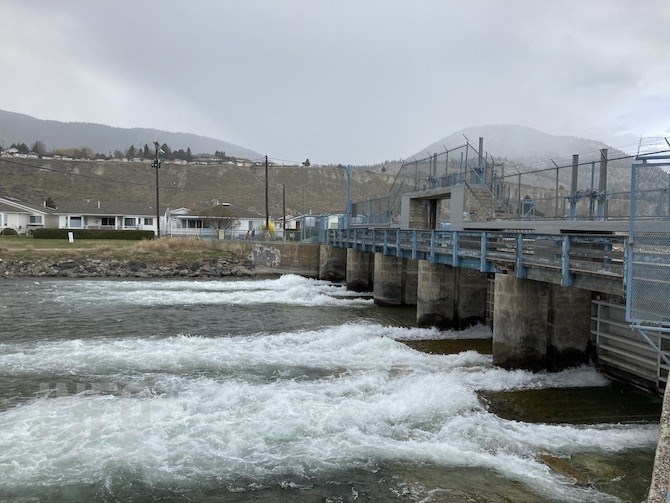
The dam controlling outflows from Okanagan Lake in Penticton is just one piece of the lake control system. It's projected to take seven years just to study what needs to be done to upgrade the system.
(STEVE ARSTAD / iNFOnews.ca)
November 01, 2021 - 7:31 AM
The debate over how the level of Okanagan Lake is controlled has gone on for years but it will be many more years before anything is done about it.
At issue is the fact that the system in place to control the lake level dates back to the 1950s and is incapable of adjusting to dramatic changes in the amount of water flowing into the lake that can lead to floods, as happened in 2017 and 2018.
In order to minimize the risk of flooding in the spring, the level of the lake is drawn down so much that in drought years, like 2021, it doesn’t refill by the fall.
“Our infrastructure was never built to react to high inflows,” Shaun Reimer, the Ministry of Forest’s section head for public safety in the Okanagan and the man responsible for controlling the flow out of Okanagan Lake at Penticton, told the Okanagan Basin Water Board in October 2020. “We know we have to make changes.”
The board listened, did a “gap analysis” to see what studies were needed to update the system and, on Tuesday, Nov. 2, the board will review the province’s response — a 71-page report called “Plan of Study for Modernizing the Okanagan Lake Regulation System: Final Report.”
It calls for a total of 18 studies in five categories spread over the next seven years.
Category One, for example, includes seven studies.
It’s called: “Improved foundation to support Okanagan Lake Regulation System operations.” It includes studies into things like how to improve the operating system documentation, improve forecasting models for inflows and “Refine mainstem lake bathymetry.”
The real concern, as Reimer has noted in the past, is that the dam at Penticton cannot let out enough water when there are big rain storms or fast snowmelts. That means he has to try to figure out what the weather will be like months ahead of time as he starts to draw down the lake each January.
READ MORE: Controlling the flow of water through the Okanagan Lake system an imperfect science
If the Penticton dam is replaced so it can let out more water, that means flooding land downstream unless the entire Okanagan River channel is expanded, so any changes have to be system-wide.
READ MORE: Battling floods and droughts in the Okanagan depends on more than a dam in Penticton
In the meantime, concerns are being raised at the other end of the spectrum as the summer 2021 drought has led to historically low lake levels.
“Traditional spawning beds are left dry in crucial areas of the lake shore,” Vernon Mayor Victor Cumming wrote in a letter to the provincial government that was copied to the water board. “Public access points are often rock and mud flats. Water levels at public boat launches have dropped below long used pads, often leaving the launch unusable and dangerous.”
Residents who draw water from the lake have water lines that are normally below water and, therefore, not subject to freezing. Many are now exposed, Cumming wrote.
Even the Okanagan Basin Water Board’s milfoil rototilling program, which started earlier this month, is impacted.
The condition of the boat launches means their machines will have to be lifted into the lake using cranes more often and they may not be able to work in traditional areas because the water is too shallow, another report going to the board says.
The upside of the low water levels may mean milfoil will be killed by wave action and freezing, the report says.
“The next steps for this review have not been clearly defined,” Anna Warwick Sears, the board’s executive director, writes in her report to the board. ”Having the report in hand, we will be in a better position to seek funding from the province, Government of Canada, and other funding agencies.”
The provincial report doesn’t give any estimate as to the cost of the studies but does say the funding for the whole series of studies should be in place at the start.
“These costs depend significantly on the approach taken to deliver the study program, and on the distribution of the work between government, ONA (Okanagan Nation Alliance), the private sector, and academia,” the executive summary of the report states.
READ MORE: Time for B.C. government to get serious about Okanagan Lake flooding: OBWB
To contact a reporter for this story, email Rob Munro or call 250-808-0143 or email the editor. You can also submit photos, videos or news tips to the newsroom and be entered to win a monthly prize draw.
We welcome your comments and opinions on our stories but play nice. We won't censor or delete comments unless they contain off-topic statements or links, unnecessary vulgarity, false facts, spam or obviously fake profiles. If you have any concerns about what you see in comments, email the editor in the link above.
News from © iNFOnews, 2021